Exploring Big Island Surf Reports: Conditions & Culture
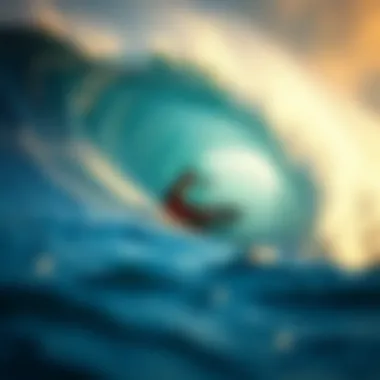
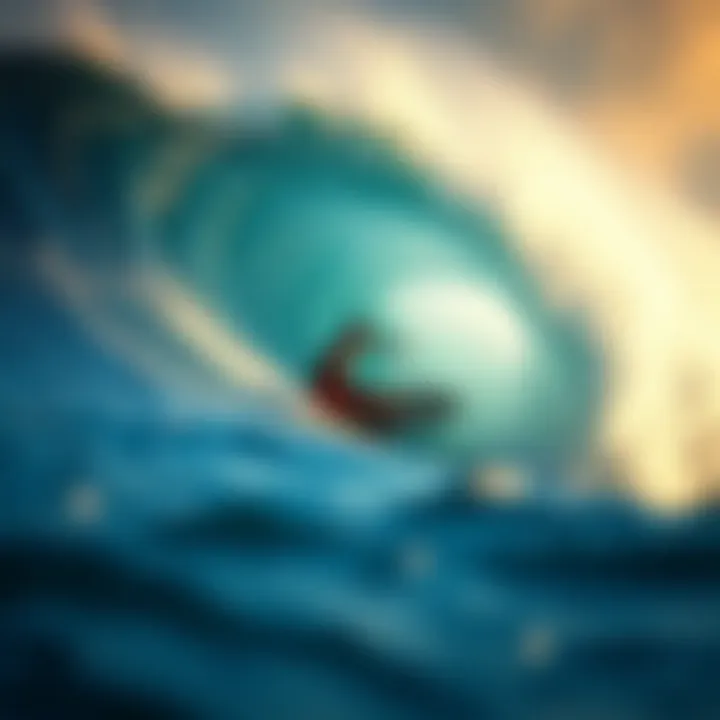
Intro
The Big Island of Hawaii is more than just a slice of paradise—it's a haven for surfers from around the globe. While the pristine waters and lush landscapes may beckon, it's the waves that truly grip the heart of any surfer worth their salt. Understanding surf reports is paramount for anyone looking to ride those Hawaiian swells. A successful day on the water hinges on reading the tide, understanding local surf breaks, and knowing the seasonal variations that can dictate surf conditions.
This article aims to demystify those surf reports, breaking them down into essential components that impact your surfing experience. From analyzing wave conditions and exploring local surf culture to providing practical tips, our guide serves both the rookie and the seasoned pro.
It’s about more than just catching the next wave; it’s about understanding the environment you're surfing in, the culture that surrounds you, and the equipment that can make or break your time on the board. As we delve into this comprehensive guide, keep in mind that the spirit of surfing is all about connection—be it to the ocean, fellow surfers, or the surf community as a whole.
Foreword to Surf Reporting on the Big Island
Surfing on the Big Island is not just a pastime; it's a way of life. For enthusiasts, understanding surf reports holds a significant weight in enhancing their experience on the water. These reports guide surfers by providing critical information about conditions that can make or break a perfect day on the waves.
Understanding Surf Reports
A surf report serves as a lighthouse for surfers navigating the ocean's myriad of conditions. These reports often break down key elements like wave height, swell direction, and wind patterns. For instance, a report might indicate that the waves are breaking at six feet, coming from the northeast, with offshore winds—ideal for riding. By interpreting this info, surfers can tailor their outings to the most promising spots and times to catch the swell.
Moreover, surf reports are updated regularly, offering real-time insights. Many surfers follow these updates like hawks; a slight change in wind direction or a shift in tide can change the surfing landscape. This dynamism in nature makes accurate reporting vital, ensuring that surfers aren't left with only a splash in the face instead of the ride of their lives.
Importance of Accurate Forecasting
Accurate forecasting in surf reports isn't merely about numbers and jargon; it translates to surfable days versus skippable ones. Imagine setting out early with your board, the sun barely cracking over the horizon, only to find flat, lifeless water. That's the reality when reports fail to deliver clarity.
Accurate surf reports can mean the difference between a great day on the water and a disappointing trip.
The ripple effects are significant—knowing the swell's pattern can help in choosing the right breaks. For example, spots like Honolii in Hilo are known for holding swell well during certain conditions. Thus, good forecasting can enhance not only individual experiences but also communal gatherings among surfers.
In addition to practical implications, accurate forecasting plays an essential role in safety. It can alert surfers about hazards like strong rip currents or changing tides. Having the inside scoop on such risks not only protects individuals but also fosters a more responsible surfing culture.
In summary, an in-depth look at surf reporting on the Big Island is crucial for any serious surfer. With the right reports and tools, riders can maximize their days on the water, embracing both the thrill and respect that the ocean demands.
Key Factors Influencing Surf Conditions
Understanding the key elements that influence surf conditions is critical, especially for those looking to catch the perfect wave on the Big Island. The interplay of various factors such as wave height, wind conditions, and tides can drastically affect surfability and the overall experience. Recognizing how these components work allows surfers to better plan their outings and maximize their enjoyment.
Wave Height and Period
Wave height is often the first thing surfers look at when checking surf reports. It offers a quick indication of the surf's potential. A wave's height can vary significantly based on several factors like storms, wind patterns, and ocean currents. On the Big Island, for instance, a wave height of 2 to 4 feet is generally considered manageable for most recreational surfers. For those experienced, heights ranging from 5 to 8 feet provide an exhilarating challenge, while anything above that signals a serious commitment to ride.
The period of the wave, which refers to the time interval between successive waves, is just as important as height. A longer wave period often means that waves have traveled over a greater distance and, therefore, can pack more punch when they hit the break. So while a short, choppy wave may look less intimidating, a well-formed set with a longer period can deliver a far more rewarding ride. Surfers can usually expect to see reports providing information on both height and period, aiding them in making informed decisions about when to hit the water.
Wind Conditions
Next on the checklist are wind conditions, which can make or break a surf session. Wind direction and speed play crucial roles in shaping the quality of the waves. On the Big Island, the trade winds typically blow from the northeast, creating ideal conditions at certain breaks. This is why getting familiar with local wind patterns is important.
Strong winds can cause choppy waters, leading to less favorable surfing conditions. Conversely, light offshore winds often smooth out the water’s surface and enhance wave formation, which is perfect for surfers trying to catch that ideal wave. Ideally, surfers should aim for times when the wind is calm or blowing off the land, providing favorable conditions for a quality surfing experience.
Tide Influences
Tides are another vital factor to consider when planning a surf trip. The Big Island experiences both spring and neap tides, and these fluctuations can significantly influence surf conditions. Each surf break reacts differently to the changing tides; some spots work best at low tide, while others are more forgiving at high tide.
For example, certain breaks may reveal shallow reefs at low tide, creating fast, hollow waves that experienced surfers often seek. On the other hand, high tide can soften the waves, making them more accessible for beginners. Thus, understanding tide schedules can help surfers predict when to surf specific spots.
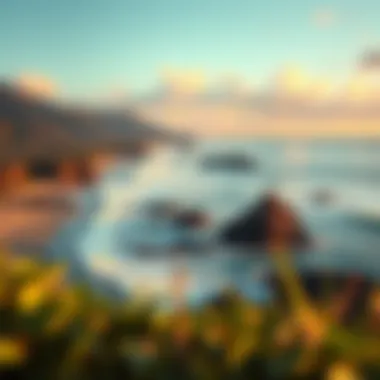

"Knowing when to surf according to tide can enhance your session, making it efficient and enjoyable."
In summary, the interplay of wave height, wind conditions, and tides constitutes the foundational knowledge necessary for any surfer on the Big Island. By keeping an eye on these factors and learning how they impact the local surf breaks, surfers can elevate their skills and find the ideal conditions that fit their level of experience.
Prominent Surf Breaks on the Big Island
Surf breaks on the Big Island are not merely locations; they are the heart and soul of the island's surf culture. Each area offers its unique charm, challenge, and experience, catering to various skill levels and preferences. Understanding these prominent surf breaks can significantly enhance a surfer's experience. Knowledge of each break helps when deciding where to paddle out, ensuring safety and enjoyment.
Kona Coast Highlights
On the western side of the Big Island lies the Kona Coast, well-loved for its clear waters and consistent swells. One of the highlights here is Banyans, a spot that attracts both beginners and seasoned surfers alike. The waves can range from mellow rolling swells ideal for learners to more intense sets that test advanced skills. One must keep an eye on the shifting currents, as they can catch inexperienced surfers off guard.
Another favorite is Kona Surfing School Beach, a prime spot for those new to the sport. The instructors often utilize this location due to its gentle break and manageable waves. The vibrant atmosphere and fellow surfers create a welcoming community that many cherish.
- Positioning: Understanding where to sit or take off is crucial. Watching others is beneficial in figuring out the best lines.
- Safety: Always be conscious of other surfers and their right of way.
Hilo Side Discoveries
On the eastern shore of the Big Island, Hilo offers a different surfing landscape. The surf here is often less crowded compared to the Kona Coast, allowing surfers to connect more deeply with the natural elements. Coconut Island is one hidden treasure where surfers can enjoy more than just waves. The scenery is breathtaking; the lush backgrounds provide a striking contrast to the ocean's blue hues.
Hilo's breaks are often influenced by the weather. Windy days can lead to choppy waters, so surfers need to be aware of the forecasts. Hilo Bay also has several areas suitable for all skill levels, offering everything from rolling waves for beginners to sharper, more powerful surges for advanced surfers.
"Exploring the Hilo side feels like discovering a whole new world of waves. It’s less about the crowd and more about the experience."
Hidden Gems for Advanced Surfers
For those looking for hidden gems, the Big Island has plenty of spots that cater specifically to advanced surfers seeking a thrilling ride. One such location is Jaws—also known as Peahi, famous not only on the Big Island but around the world for its colossal waves. This spot is best for those looking for a serious challenge, especially during the winter months when swells swell dramatically. Only the brave and experienced dare to ride these giants.
Another noteworthy break is Pine Trees, found near Hilo. It requires a bit of effort to access but rewards adventurous surfers with powerful barrels and less traffic, allowing for longer rides. Surfers should be prepared for various conditions and elements, as this break can be unpredictable. These secret spots can also provide excellent opportunities for those looking to escape the more frequented surf scenes.
- Experience Level: Confirm your skills match the conditions. Never overlook safety.
- Respect Local Etiquette: Engaging positively with local surfers not only fosters good vibes but also secures your spot in these exclusive lineups.
Seasonal Variations in Surf Conditions
Understanding seasonal variations in surf conditions on the Big Island is pivotal for surfers aiming to optimize their riding experience. Each season presents unique characteristics, and these fluctuations can influence not only the quality of waves but also the overall surfing climate. The nuances of winter swells and summer calms shape the choice of when to paddle out, ensuring surfers can harness the best waves for their skill levels and preferences.
Winter Swells
In winter, the Big Island transforms into a surfer's paradise, with robust swells that attract wave riders from all corners of the globe. The North Shore experiences the most significant action during this season. Typically, swells generate in the northern Pacific, reaching the islands after a long journey. Here’s what makes winter swells crucial:
- Powerful Waves: The winter months can bring intense waves, often exceeding 15 feet at certain breaks. For advanced surfers, this opens up a realm of thrilling challenges and rewards.
- Big Competitions: Major surf competitions, like the Big Wave Invitational, take place during this period. This not only attracts the world’s top surfers but also creates a vibrant atmosphere.
- Diverse Conditions: The diverse surf breaks on the Big Island cater to different skill levels. Experienced surfers can take on the heavier breaks, while intermediate surfers might seek less extreme conditions.
However, with great waves come hazards. Rip currents and shifting tides require surfers to be vigilant and prepared. Local knowledge is invaluable to navigate these conditions safely.
"In winter, the ocean becomes a different beast entirely, requiring respect and skill to ride its waves."
Summer Calm
As summer rolls in, the Big Island transitions dramatically, offering a more mellow vibe on the waves. The swells diminish significantly, providing an ideal environment for beginners and those looking for a less intense experience. Here’s what to expect in the summer months:
- Gentler Waves: Summer conditions generally yield smaller, more forgiving waves that are perfect for novice surfers honing their skills. This allows for more practice and less anxiety about wipeouts.
- Ideal for Family Fun: Many families flock to the beaches during this season. The calm waters make it a perfect time for recreational surfing, stand-up paddleboarding, or simply enjoying a day by the shore.
- Less Crowded Lineups: With the diminishing swells, some surfers tend to take a break during summer. This can mean less crowded lineups, allowing surfers to enjoy the waves without the hustle and bustle of winter crowds.
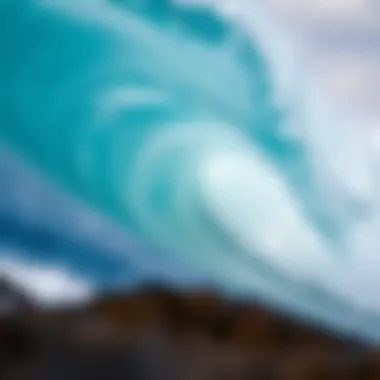
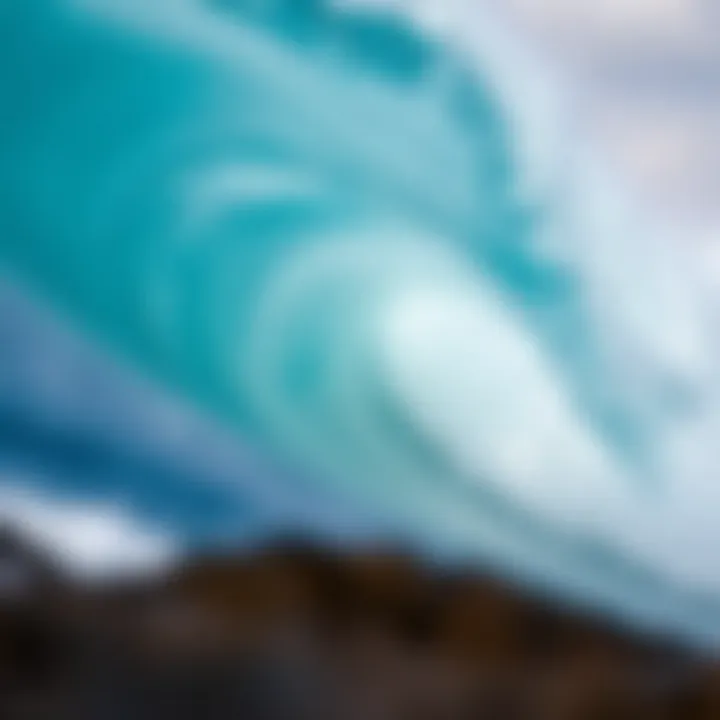
Nonetheless, summer surfing doesn’t lack excitement. Surf schools, camps, and informal competitions still thrive, fostering a sense of community among local and visiting surfers. Choosing the right gear during this period becomes critical; lighter boards and shorter wetsuits or board shorts often make for a more enjoyable experience.
In summary, understanding these seasonal shifts is essential for anyone looking to ride the waves in Hawaii efficiently. Accurately gauging the conditions will lead not only to a better surfing experience but also to a deeper appreciation of the ocean's cyclic nature.
Tech Tools for Tracking Surf Reports
In the digital age, tech tools serve as the lifeline for surfers seeking to catch the perfect wave on the Big Island. Good surf reporting is more than just a la-dee-da guess about wave condition; it’s a science at your fingertips. With many surf spots varying drastically in surf quality due to local conditions, relying on traditional methods alone won’t cut it. This section dives deep into how various tech tools can assist in evaluating surf conditions, making informed decisions, and ultimately enhancing the surfing experience.
Website Resources
Web resources are like a treasure trove of information for surfers. When you click through these sites, you get a bird's-eye view of surf conditions updated frequently, reducing guesswork. For example, sites like Surfline and Magicseaweed offer real-time surf forecasts, tide charts, and acclaimed surf cams showing live conditions. Their user interface is designed for clarity, helping surfers pick the right spot right before heading out non the less.
- Surfline: Their extensive network of live cameras spreads across Hawaii, providing insights into wave size, wind speed, and tide levels.
- Magicseaweed: Offers detailed forecasts, weather conditions, and even crowd reports, all tailored to the preferences of local surfers.
- Windy: This site goes beyond just surf; it provides wind, rain, and other atmospheric data essential for making wise decisions on when to surf.
"Keeping an eye on the conditions beforehand gives you an edge; it’s the difference between nailing a great session and splashing around in mushy surf."
Not only that, but many of these websites feature forums and community boards where surfers share experiences, tips, and even localized information on lesser-known surf spots. This collective knowledge can enrich your surfing journey.
Mobile Applications
In our fast-paced lives, having surf reports in the palm of your hand is invaluable. Mobile applications take immediacy to the next level, often combining the vast databases of surf condition into an easy-to-navigate format. Imagine standing at the beach, phone in hand, pulling up a reliable app to see whether that swell you were hoping for is indeed peaking.
- Surfline App: This handy tool delivers not only forecasts but also curated news from trusted contributors. The app’s live cam feature links back to its website, providing essential updates wherever you go.
- MySurf: A more community-focused app, it allows you to mark your favorite surf spots and get real-time updates from fellow surfers in the area. It’s a shared source of information, creating a sense of camaraderie in the surfing community.
- Windy App: While generally focused on wind conditions, this application is crucial for surfers who know that the right wind can make or break a good session. It combines forecasting with weather data seamlessly.
Having these tools on your phone brings a world of surf conditions right to your fingertips. Surfing is not just about riding the wave; it’s a dance with nature, which requires real-time knowledge and adaptability. Embracing these technological advancements ensures you're ready to catch the best surf on the Big Island.
Understanding Surf Culture on the Big Island
Surf culture on the Big Island of Hawaii is more than just a sport; it's a way of life. This culture represents a unique blend of history, community, and respect for the ocean that goes beyond the simple act of riding waves. When surfing in this paradise, understanding the local culture is vital for several reasons.
First, it fosters a sense of belonging. Surfers often share tips, stories, and camaraderie that enhance their experience. The relationships forged in the water can deepen one’s appreciation for the ocean and the surf spots. This tight-knit community often welcomes newcomers who show respect towards both the local surfers and the ocean itself.
Moreover, local surf culture emphasizes environmental stewardship. Many surfers on the Big Island advocate for protecting Hawaii's delicate marine ecosystems and often participate in beach cleanups or conservation efforts. By understanding this aspect of the surf culture, surfers can contribute positively and be part of something greater than themselves.
The etiquette of surfing also derives from this culture. New surfers might find that grasping the intricacies of wave priority and respect for other riders is paramount in fostering a positive surfing atmosphere. Understanding these nuances helps newcomers avoid misunderstandings that could lead to unnecessary conflict in the water.
Finally, the culture is steeped in Hawaiian traditions and values, emphasizing a strong connection to the land and sea. Recognizing the importance of these values can enrich one’s surfing experience, making it far more profound than just catching a wave. Thus, immersed in the local surf culture, a surfer will not only improve their skills but also become a part of the rich tapestry that is the oceanic life of the Big Island.
The Community Aspect
The community aspect is at the heart of surf culture on the Big Island. Here, the beach and the ocean serve as communal spaces where friendships blossom and stories are shared. Surfers often find themselves in a diverse group, with each individual bringing their own stories, styles, and backgrounds to the lineup.
In many ways, surfing on the Big Island embodies the Hawaiian philosophy of "Aloha", which extends beyond a simple greeting to encompass love, peace, and a sense of harmony among people. It encourages surfers to foster mutual respect both in and out of the water. Locals appreciate when visitors show awareness of this framework, leading to a more harmonious surf environment.
Whether it's hanging out at a local surf shop, catching a session at a favored break, or joining in on community events, these interactions cultivate friendships and a shared love for the ocean. For locals, the beach represents more than just a place to surf; it's where memories are made and cherished.
Events and Competitions
Surfing competitions are crucial to the Big Island surf culture. They aren't just about winning trophies; they reflect the spirit of competition and camaraderie among surfers in these beautiful waters. Events range from informal gatherings at local breaks to more structured competitions attracting top athletes from around the world.
One of the highlights is the Hawaiian Surfing Championships, which showcases the talents of surfers from all backgrounds. This tournament provides local surfers an opportunity to gain recognition and, for many, it acts as a stepping stone into the wider surfing community. Participation in these events can also lead to sponsorship opportunities, opening doors within the surfing industry.


Moreover, these competitions often include various categories, such as longboarding or shortboarding, making it inclusive for all types of riders. When these events are held, they inject a palpable energy into local beaches. Spectators gather, creating a buzz as surfers battle the elements and each other for glory.
In addition, community festivals often accompany surf competitions, further solidifying the culture of togetherness. Live music, food trucks, and local artisans showcase the rich Hawaiian heritage, giving visitors a taste of the islands beyond just surfing.
To deepen your understanding of events and competitions, check local surfing organizations or websites such as HawaiiSurf.org and Surfline for the latest on competitions and community happenings.
Through events and the shared experiences they create, the Big Island surf culture remains vibrant, continuously evolving while staying true to its roots. This celebration of surfing is what makes the Big Island a special place for surfers of all levels.
Safety Considerations for Surfers
Surfing on the Big Island can be a thrilling experience but it also comes with its fair share of risks. Understanding safety considerations is not just about protecting oneself; it's also about ensuring the enjoyment and longevity of the sport. Surfing, like any adventurous activity, demands a vigilant approach to keep surfers out of harm’s way. This section delves into the potential hazards one may encounter and the emergency protocols that should be followed.
Hazards to Be Aware Of
Surfing can be unpredictable, and there are several hazards that surfers need to keep in mind when navigating the waters of the Big Island:
- Strong Currents: The ocean is not always friendly. Rip currents can pull even the strongest swimmer out to sea before they know it. Surfers should always have a good understanding of the water’s condition.
- Unpredictable Waves: Sometimes waves can pack a punch, especially if you’re in the wrong spot at the wrong time. Surfers need to be able to read the waves to stay safe and maintain control.
- Reef and Rocks: Many surf spots in the Big Island are shallow with hidden coral reefs or rocks. Wipeouts can lead to serious injury if surfers hit these underwater obstacles. It is wise to scout the area before paddling out.
- Marine Life: Encounters with marine life, like jellyfish or even sharks, are part of the ocean's unpredictability. Knowing how to react during such encounters can be essential.
- Weather Changes: The weather can shift quickly, bringing rain and high winds which can alter surf conditions dramatically. Awareness of the forecast is crucial.
Emergency Protocols
Before hitting the waves, it’s important for surfers to be equipped with basic knowledge of emergency protocols. These can be crucial in case of an incident:
- Know the Location of the Nearest Lifeguard: Knowing where help is can make all the difference. If you're surfing in a popular area, there are usually lifeguards on duty.
- Have a Surf Buddy: Whenever possible, don’t surf alone. Having a buddy means someone is always watching your back and can assist you if something goes wrong.
- First Aid Kit: Regardless of your skill level, it’s wise to carry a basic first aid kit. Band-aids for minor scrapes, antiseptics for cuts, and a phone to call for help can prove invaluable.
- Rescue Techniques: Familiarize yourself with basic rescue techniques or attend a surf safety class. Knowing how to assist someone in distress can save lives.
- Stay Calm: If an emergency arises, keeping your wits about you is vital. Panic can lead to poor decision-making. Always assess the situation before acting.
"Surfing is a sport that requires respect for the ocean and awareness of its unpredictability. Always prioritize safety to fully enjoy the experience."
By staying informed about potential hazards and following essential safety protocols, surfers can have a safe and rewarding experience on the waves of the Big Island. Knowing what to expect and preparing for any eventualities makes for a much more enjoyable surfing adventure.
What to Expect When Surfing the Big Island
Surfing the Big Island offers a unique experience that varies significantly from what many surfers may be accustomed to. The island’s diverse landscape and distinct wave conditions present surfers with opportunities that can’t be found elsewhere. It’s essential to understand not only the ocean’s behavior but also the local culture and etiquette surrounding surfing. Knowing what to expect can prevent misunderstandings and enhance your overall experience on the powerful waves of Hawaii.
Preamble to Local Etiquette
Surfing in Hawaii, and particularly on the Big Island, comes with an unwritten set of rules that every surfer should respect. The locals have a deep connection to their waters, much like a family caring for their home. Acknowledging this connection fosters goodwill and respect among surfers. Here are essential points to keep in mind:
- Respect the Lineup: Always wait your turn in the water. If someone is already on a wave, it’s best to let them ride it out before paddling for another. It can be tempting to charge in, but this could lead to confrontation.
- Be Mindful of Others: A crowded surf break can easily lead to chaos. Keep your distance from others, and be aware of their positioning. Watch for signals or gestures from fellow surfers—it’s all part of reading the room.
- Say Aloha: A simple greeting goes a long way. When you’re a newcomer, show respect with a friendly “Aloha” as you enter the water. It’s a sign of goodwill and can help establish rapport with local surfers.
- Pay Attention to Conditions: Before hitting the waves, get a feel for the surf. Knowing the breaks, currents, and hazards is vital. The ocean can be moody, and understanding what it offers up that day is part of surf culture.
Choosing the Right Gear
Having the appropriate gear tailored to the Big Island’s specific conditions can significantly enhance your surfing experience. The gear you choose should align with the type of waves you plan to surf and your skill level. Here’s what to consider:
- Board Selection: Depending on your proficiency, you might want a shortboard for performance or a longboard for a more cruisy ride. For the Big Island, where waves can vary drastically, having one of each could be beneficial.
- Wetsuits and Rash Guards: The water temperatures around the island typically range from 74°F to 80°F. Generally, you might not need a thick wetsuit, but a light rash guard or a shorty can help against sun exposure and minor rashes from the board.
- Leash: Don’t skimp on the leash. The ocean can be tumultuous, and a solid leash ensures your board doesn't become a dangerous projectile. Durability is key, so opt for a leash suited for big waves if you're heading to more demanding breaks.
- Accessories: Don’t forget essentials such as sunscreen—preferably reef-safe to protect marine life—polarized sunglasses, and perhaps a surf hat for those sun-soaked sessions. No one wants to end the day with sunburn or squinting against the sun.
Choosing the right gear not only caters to the waves but also demonstrates respect for the local surfing community and environment. With these guidelines in mind, you’re well on your way to an unforgettable surfing adventure on the Big Island.
“Respect the ocean, and it will respect you in return.”
For more information about surf culture and etiquette in Hawaii, you might find this resource useful. Additionally, check out local surf groups on Facebook or peer advice on Reddit to connect with other surfers sharing their experiences.
Epilogue
As we wrap up our look into the intricacies of surf reporting on the Big Island, it’s clear that understanding the nuances of surf conditions goes far beyond the simple act of riding waves. Accurate surf reports provide essential information that can turn an average surf day into an extraordinary one. As surfers, knowing the wave heights, tide patterns, and local wind conditions can significantly enhance both safety and enjoyment out on the water.
Final Thoughts on Surfing in Hawaii
Hawaii is sometimes referred to as the mecca of surfing, and for good reason. Its sweeping coastlines, powerful swells, and rich surf culture draw newcomers and seasoned surfers alike. Each surf session offers an opportunity not only to experience exhilarating rides but also to connect with the ocean in a profound way.
While the thrill of catching a wave might be the main attraction, it’s important to remember the respectful nature of the sport. Learning about local etiquette ensures that everyone enjoys the experience. Whether you’re a beginner running into the surf for the first time or a pro perfecting your maneuvers, embracing the community and cultural aspects of surfing is vital.



